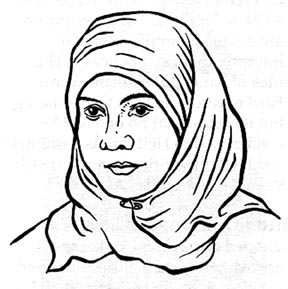 |
| Hijab III&E Brochure Series (published by The Institute of Islamic Information and Education (III&E) and reproduced in electronic form by Islamic Academy for Scientific Research with permission) --------------------------------------------------------- THE QUESTION OF HIJAB: SUPPRESSION OR LIBERATION? "Why do Muslim women have to cover their heads?" This question is one which is asked by Muslim and non-Muslim alike. For many women it is the truest test of being a Muslim. The answer to the question is very simple - Muslim women observe HIJAB (covering the head and the body) because Allah has told them to do so. "O Prophet, tell your wives and daughters and the believing women to draw their outer garments around them (when they go out or are among men). That is better in order that they may be known (to be Muslims) and not annoyed..." (Qur'an 33:59) Other secondary reasons include the requirement for modesty in both men and women. Both will then be evaluated for intelligence and skills instead of looks and sexuality. An Iranian school girl is quoted as saying, "We want to stop men from treating us like sex objects, as they have always done. We want them to ignore our appearance and to be attentive to our personalities and mind. We want them to take us seriously and treat us as equals and not just chase us around for our bodies and physical looks." A Muslim woman who covers her head is making a statement about her identity. Anyone who sees her will know that she is a Muslim and has a good moral character. Many Muslim women who cover are filled with dignity and self esteem; they are pleased to be identified as a Muslim woman. As a chaste, modest, pure woman, she does not want her sexuality to enter into interactions with men in the smallest degree. A woman who covers herself is concealing her sexuality but allowing her femininity to be brought out. The question of hijab for Muslim women has been a controversy for centuries and will probably continue for many more. Some learned people do not consider the subject open to discussion and consider that covering the face is required, while a majority are of the opinion that it is not required. A middle line position is taken by some who claim that the instructions are vague and open to individual discretion depending on the situation. The wives of the Prophet (S) were required to cover their faces so that men would not think of them in sexual terms since they were the "Mothers of the Believers," but this requirement was not extended to other women. The word "hijab" comes from the Arabic word "hajaba" meaning to hide from view or conceal. In the present time, the context of hijab is the modest covering of a Muslim woman. The question now is what is the extent of the covering? The Qur'an says: "Say to the believing man that they should lower their gaze and guard their modesty; that will make for greater purity for them; and Allah is well acquainted with all that they do. And say to the believing women that they should lower their gaze and guard their modesty; and that they should not display their beauty and ornaments except what must ordinarily appear thereof; that they should draw their veils over their bosoms and not display their beauty except to their husbands..." (Qur'an 24:30-31) These verses from the Qur'an contain two main injunctions: A woman should not show her beauty or adornments except what appears by uncontrolled factors such as the wind blowing her clothes, and the head covers should be drawn so as to cover the hair, the neck and the bosom. Islam has no fixed standard as to the style of dress or type of clothing that Muslims must wear. However, some requirements must be met. The first of these requirements is the parts of the body which must be covered. Islam has two sources for guidance and rulings: first, the Qur'an, the revealed word of Allah and secondly, the Hadith or the traditions of the Prophet Muhammad (S) who was chosen by Allah to be the role model for mankind. The following is a Tradition of the Prophet: "Ayesha (R) reported that Asmaa the daughter of Abu Bakr (R) came to the Messenger of Allah (S) while wearing thin clothing. He approached her and said: 'O Asmaa! When a girl reaches the menstrual age, it is not proper that anything should remain exposed except this and this. He pointed to the face and hands." (Abu Dawood) The second requirement is looseness. The clothing must be loose enough so as not to describe the shape of the woman's body. One desirable way to hide the shape of the body is to wear a cloak over other clothes. However, if the clothing is loose enough, an outer garment is not necessary. Thickness is the third requirement. The clothing must be thick enough so as not to show the color of the skin it covers or the shape of the body. The Prophet Muhammad (S) stated that in later generations of his ummah there would be "women who would be dressed but naked and on top of their heads (what looks like) camel humps. Curse them for they are truly cursed." (Muslim) Another requirement is an over-all dignified appearance. The clothing should not attract men's attention to the woman. It should not be shiny and flashy so that everyone notices the dress and the woman. In addition there are other requirements: Women must not dress so as to appear as men. "Ibn Abbas narrated: 'The Prophet (S) cursed the men who appear like women and the women who appear like men.'" (Bukhari) Women should not dress in a way similar to the unbelievers. The clothing should be modest, not excessively fancy and also not excessively ragged to gain others admiration or sympathy. Often forgotten is the fact that modern Western dress is a new invention. Looking at the clothing of women as recently as seventy years ago, we see clothing similar to hijab. These active and hard-working women of the West were not inhibited by their clothing which consisted of long, full dresses and various types of head covering. Muslim women who wear hijab do not find it impractical or interfering with their activities in all levels and walks of life. Hijab is not merely a covering dress but more importantly, it is behavior, manners, speech and appearance in public. Dress is only one facet of the total being. The basic requirement of the Muslim woman's dress apply to the Muslim man's clothing with the difference being mainly in degree. Modesty requires that the area between the navel and the knee be covered in front of all people except the wife. The clothing of men should not be like the dress of women, nor should it be tight or provocative. A Muslim should dress to show his identity as a Muslim. Men are not allowed to wear gold or silk. However, both are allowed for women. For both men and women, clothing requirements are not meant to be a restriction but rather a way in which society will function in a proper, Islamic manner. Mary C. Ali --------------------------------------------------------- INTRODUCTION OF III&E The Institute of Islamic Information and Education (III&E) is dedicated to the cause of Islam in North America through striving to elevate the image of Islam and Muslims by providing the correct information about Islamic beliefs, history and civilizations from the authentic sources. Enquiries are welcome. For more information please contact: The Institute of Islamic Information and Education P.O. Box 41129 Chicago, Illinois 60641-0129 U.S.A. Tel. (312) 777-7443 Fax. (312) 777-7199 Reprinted with the permission of World Assembly of Muslim Youth (WAMY), P.O. Box 10845, Riyadh 11443, Saudi Arabia |
| Hijab |
| HIJAB IN THE WORKPLACE Q&A Q. What are the requirements for Muslim women's dress? A: Rules regarding Muslim women's (and men's) attire are derived from the Quran, Islam's revealed text, and the traditions (hadith) of the Prophet Muhammad (peace be upon him). In the Quran, God states: "Say to the believing men that they should lower their gaze and guard their modesty...And say to the believing women that they should lower their gaze and guard their modesty; that they should not display their beauty and adornments except what (must ordinarily) appear thereof; that they should draw their veils over their bosoms and not display their beauty except to their husbands, their fathers...(a list of exceptions)" [Chapter 24, verses 30-31] Also, "O Prophet! Tell thy wives and daughters, and the believing women, that they should cast their outer garments over their persons...that they should be known and not molested." [Chapter 33, verse 59] In one tradition, the Prophet Muhammad is quoted as saying: "...If the woman reaches the age of puberty, no part of her body should be seen but this --- and he pointed to his face and hands." From these and other references, the vast majority of Muslim scholars and jurists, past and present, have determined the minimum requirements for Muslim women's dress: 1) Clothing must cover the entire body, with the exception of the face and the hands. 2) The attire should not be form fitting, sheer or so eye-catching as to attract undue attention or reveal the shape of the body. There are similar, yet less obvious requirements for a Muslim male's attire. 1) A Muslim man must always be covered from the navel to the knees. 2) A Muslim man should similarly not wear tight, sheer, revealing, or eye-catching clothing. In addition, a Muslim man is prohibited from wearing silk clothing (except for medical reasons) or gold jewelry. A Muslim woman may wear silk or gold. (References: "The Muslim Woman's Dress," Dr. Jamal Badawi, Ta-Ha Publishers; "Hijab in Islam," Maulana Wahiduddin Khan, Al-Risala Books; "The Islamic Ruling Regarding Women's Dress," Abu Bilal Mustafa Al-Kanadi, Abul-Qasim Publishing; "Islamic Dress," Muslim Women of Minnesota; "Your Hijab and U.S. Law," North American Council for Muslim Women) Q. Is Islamic dress appropriate for modern times? A: Islamic dress is modern and practical. Muslim women wearing Islamic dress work and study without any problems or constraints. Q. Does Islamic dress imply that women are submissive or inferior to men? A: Islamic dress is one of many rights granted to Islamic women. Modest clothing is worn in obedience to God and has nothing to do with submissiveness to men. Muslim men and women have similar rights and obligations and both submit to God. Q. But aren't there Muslim women who do not wear Islamic Dress, or hijab? A: Some Muslim women choose not to wear hijab. Some may want to wear it but believe they cannot get a job wearing a head scarf. Others may not be aware of the requirement or are under the mistaken impression that wearing hijab is an indication of inferior status. Q. Why is Islamic dress becoming an issue for personnel managers and supervisors? A: The Muslim community in American is growing rapidly. Growth factors include conversions to Islam, immigration from Muslim countries and high birth rates for Muslim families. As the community grows, more Muslim women will enter the work force. In many cases, these women wish both to work and to maintain their religious convictions. It should be possible to fulfill both goals. Q. What issues do Muslim women face in the workplace? A: Muslim women report that the issue of attire comes up most often in the initial interview for a job. Some interviewers will ask if the prospective employee plans to wear the scarf to work. Others may inappropriately inquire about religious practices or beliefs. Sometimes the prospective employee, feeling pressure to earn a living, will take off the scarf for the interview and then put it on when hired for the job. Modest dress should not be equated with incompetence. Other issues include unwanted touching or pulling on scarves by other employees, verbal harassment or subtle ostracism and denial of promotion. Many Muslims also object to being pressured to attend celebrations of other religious traditions or to attend employer-sponsored celebrations at which alcohol is served. Q. What can an employer reasonably require of a woman wearing hijab? A: An employer can ask that an employee's attire not pose a danger to that employee or to others. For example, a Muslim woman who wears her head scarf so that loose ends are exposed should not be operating a drill press or similar machinery. That employee could be asked to arrange her hijab so that the loose ends are tucked in. An employer can ask that the hijab be neat and clean and in a color that does not clash with a company uniform. Q. What are the legal precedents on this issue? A: Many cases have demonstrated an employee's legal right to reasonable accommodation in matters of faith. Examples: 1) The failure of other Muslim employees to wear headscarves is legally irrelevant. The employee need only show sincerely-held religious beliefs. (E.E.O.C. v. Reads, Inc., 1991) 2) There are no health or safety concerns at issue. (Cf. E.E.O.C. Dec. No. 82-1, 1982, also E.E.O.C. Dec. No. 81-20, 1981) 3) Companies cannot give effect to private biases. In other words, just because an employer believes customers will be prejudiced against a woman in a scarf, that does not mean the employee can be fired. (Palmer v. Sidoti, 1984, also Cf. Sprogis v. United Air Lines, Inc., 1971) 4) An employer must demonstrate "undue hardship" caused by the wearing of religious attire. (TWA v. Hardison, 1977) Hardships recognized by the courts include cost to the employer or effect on co-workers. 5) Dress codes can have disproportionate impact on certain faiths. (E.E.O.C. Dec. No. 71-2620, 1971, also E.E.O.C. Dec. No. 71-779, 1970) |
 |
| Hijab: typically a scarf that covers the hair, neck and sometimes chest. This is considered the minimum in Islamic head covering. Is worn with Jilbab or abaya or street clothes (pants or long skirt or dress and long sleeves). |
| Why do Muslim women wear hijab? Obedience to Allah. Allah says in the Qur'an: "It is not for a believer, man or woman, when Allah and His messenger have decreed a matter that they should have an option in their decision. And whoever disobeys Allah and His Messenger, has indeed strayed in a plain error." Surah 33:36 Allah also said: "And tell the believing women to lower their gaze (from looking at forbidden things) and protect their private parts (from illegal sexual acts, etc) and not to show off their adornment except what must (ordinarily) appear thereof, that they should draw their veils over their Juyubihinna. (every where except face and hands)" Surah 24:31 Aisha reported that Asma the daughter of Abu Bakr came to the Messenger of Allah while wearing thin clothing. He approached her and said: O Asma! When a girl reaches the menstrual age, it is not proper that anything should remain exposed except this and this. He pointed to the face and hands. (Abu Dawood) Modesty Allah says: 'O Prophet! Tell your wives and your daughters and the women of the believers to draw their cloaks (veils) over their bodies (when outdoors). That is most convenient that they should be known and not molested.' Surah 33:59 Purity Allah had shown us the hikma (wisdom) behind the legislation of the hijab: `And when you ask them (the Prophet's wives) for anything you want, ask them from behind a screen, that is purer for your hearts and their hearts.' Surah 33:53 Taqwah (Righteousness) Allah says in the Qur'an: `O children of Adam! We have bestowed raiment upon you to cover yourselves (screen your private parts, etc) and as an adornment. But the raiment of righteousness, that is better.' Surah 7:26 The widespread forms of dresses in the world today are mostly for show off and hardly taken as a cover and shield of the woman's body. To the believing women, however the purpose is to safeguard their bodies and cover their private parts as a manifestation of the order of Allah. It is an act of Taqwah (righteousness). Imaan (Belief or Faith) Allah did not address His words about the hijab except to the believing women, Al-Mo'minat. In many cases in the Qur'an Allah refers to the "the believing women". Aisha, the wife of the prophet, addressed some women from the tribe of Banu Tameem who came to visit her and had light clothes on them, they were improperly dressed: "If indeed you are believing women, then truly this is not the dress of the believing women, and if you are not believing women, then enjoy it." What is required to be covered? There are differences of opinion on this but it is for certain that a woman must cover everything except face and hands - this according to the hadith cited above. Some say cover the face and hands. But this is not allowed when doing Hajj in Mecca. Anyway, there are many different ways of covering. As shown in the pics above, a woman has many choices. She should cover based upon what she feels is fard or obligatory after a study of hijab. I personally wear hijab only with long pants or skirts and long sleeves. I also sometimes wear a jilbab or jilbob when I wish to wear my "house" clothes for quick trips up to the store or errands. |
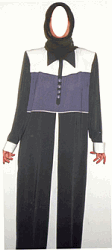 |
| Jilbab: over-garment that typically look like a floor length jacket or coat with buttons or a zipper. |
| Abayah: A more loose fitting over-garment that typically ties in front. Covers all except the hands in some cases. Sometimes is worn on the head -each country has their own style. |
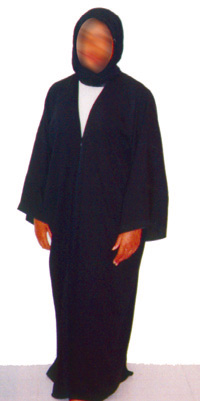 |
| Khimar: large circular long scarf head covering) that goes to varying lengths (fingertips, thigh or calf) |
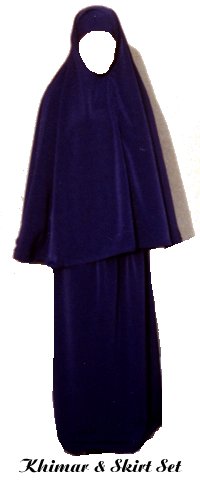 |
| Niqab: face veil - usually leaving the eyes open (can be worn with abaya, khamir or jlibab). |
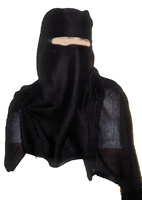 |
| Burqah: Complete covering from head to toe, including the hands with gloves (can be worn with abaya, khamir or jlibab). |
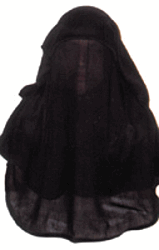 |
| Police hope for Muslim head start Hijabs are traditionally worn by Muslim women in public By BBC News Online's community affairs reporter Cindi John Muslim police officers have welcomed the Metropolitan Police's decision to introduce a traditional headscarf as a uniform option for Muslim women. The Association of Muslim Police hopes the move will encourage into the police Muslim women who had been deterred by the prospect of not being able to cover up in public. The scarf or hijab - which covers the head, neck and shoulders - is worn by some Muslim women in public as a sign of their modesty and faith. Association chairman Inspector Richard Varley said a proposal for the headscarf was put to the Met commissioner Sir John Stevens in February. Richard Varley hopes more Muslim women will now join up "We've had certainly dozens of inquires by potential Muslim female recruits but those inquiries dry up as soon as they realise they can't wear a hijab," he said. He said the latest move sent "a wider message that Muslim values are valued within the Met whether or not the officers choose to take up the offer of a hijab". With Muslims making up to one million of seven million Londoners there should be around 3,000 Muslim police officers rather than the 100 or so now in the force, the inspector added. The introduction of the hijab, with the distinctive Metropolitan police black and white check pattern, follows a similar move by the Met for Sikh officers who are allowed to wear a turban on duty. Sikh officers can wear a turban instead of helmet The new addition to the Met's uniform was also welcomed by Sir John Stevens at a conference marking the start of the second phase of the force's diversity strategy. The strategy, 'Protect and Respect' was devised after severe criticism in a report examining the force's handling of the inquiry into the murder of a black teenager, Stephen Lawrence. Progress Sir John said the force had now also signed up to the Commission for Racial Equality's Leadership Challenge, which aimed to encourage organisations to play a greater role in promoting racial equality. The commissioner said he would not be content with merely pledging support for the Challenge's aims. "I want actively to embrace them and develop them further and I know the Metropolitan Police Authority is right there with me endeavouring to make the Met a model of diversity that other organisations would wish to emulate," he said. Sir John said there had been good progress on race issues, but said more needed to be done to meet the Home Office target of 25% of officers from minority ethnic groups. Leroy Logan: "More needs to be done" The target was just over 5,000 ethnic officers, more than five times the number currently employed, he added. Black Police Association chairman Inspector Leroy Logan agreed progress had been made on race issues. But he said cases such as that of Iranian-born superintendent Ali Dizaei - suspended after allegations of dishonesty and attempting to pervert the course of justice - were a potential block to more ethnic minority recruits. "We've got to make sure that those cases are reduced, make sure that high-flyers, rising stars like Ali Dizaei are not victims of the system," he said. "We are obviously concerned that we have a proper effective investigation to make sure that all cases are resolved because that sets back recruiting the image of the organisation in so many ways and it reduces trust and confidence in the minority communities," Mr Logan added. |
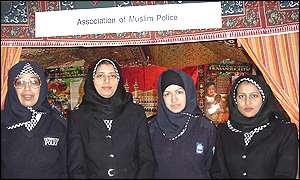 |
 |